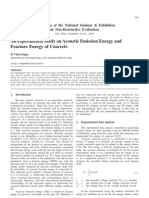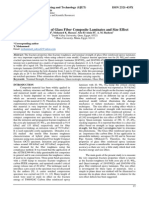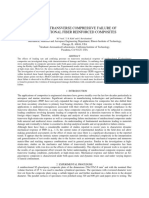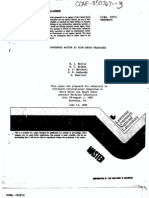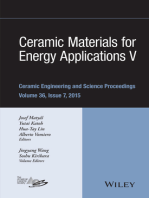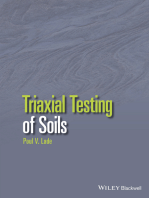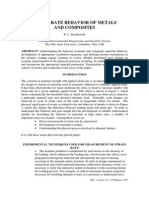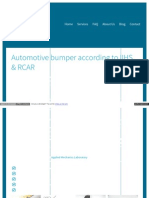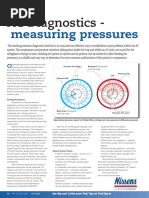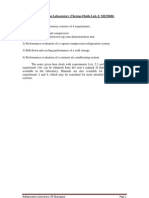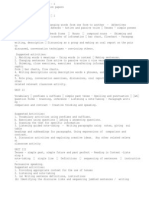Dymat00 Infl PDF
Dymat00 Infl PDF
Uploaded by
jaydeepnaruleCopyright:
Available Formats
Dymat00 Infl PDF
Dymat00 Infl PDF
Uploaded by
jaydeepnaruleOriginal Description:
Original Title
Copyright
Available Formats
Share this document
Did you find this document useful?
Is this content inappropriate?
Copyright:
Available Formats
Dymat00 Infl PDF
Dymat00 Infl PDF
Uploaded by
jaydeepnaruleCopyright:
Available Formats
INFLUENCE OF THE STRAIN RATE ON THE TENSILE STRENGTH IN ALUMINAS OF
DIFFERENT PURITY
F. Glvez, J.Rodrguez and V. Snchez Glvez
Department of Materials Science. ETSI Caminos Canales y Puertos
Polytechnic University of Madrid. Ciudad Universitaria s/n. 28040 Madrid, Spain
e-mail: fgalvez@mater.upm.es
Abstract. It is well known that the properties of the materials may be different as the strain rate increases. Advanced
ceramic materials such as aluminas, could present an increase in their strength as the strain rate becomes higher. In
this paper the investigation is focused on the influence of the strain rate on the tensile strength of alumina. The
influence of this variable on this propert y is experimentally analysed by means of two different kind of tests carried
out from low to high strain rates. The splitting test of brittle materials is a testing technique widely used at low strain
rates. It has been recently extended to dynamic conditions using the Hopkinson split pressure bar. In this work this
method is used both in static and dynamic conditions with servohydraulic machines and a Hopkinson bar. The
tensile strength of alumina has been measured at three different strain rates. The spalling test of long bars is an
additional technique that provides the dynamic tensile strength of brittle materials in uniaxial conditions. The test
procedure and the experimental details are also presented and discussed in a separate paper. This technique has also
been used to measure dynamic tensile strength of alumina at higher strain rates. The influence of the strain rate on
the tensile strength is presented and a comparison between the two kind of tests is also discussed. To identify the
physical mechanisms causing the failure, a microscope analysis of fracture surfaces using SEM has also been
performed. The study has been applied to the different specimens tested at low and high strain rates with the two
different kind of tests. The results of the fractographic analysis are presented and discussed.
1. INTRODUCTION
The effect of the strain rate on the mechanical properties of materials is well known. Mechanical properties of
ceramic materials are affected by the strain rate, and its effect on the compressive strength has been studied [1],
[2], showing an increase in strength with strain rate. But the effect of strain rate under tensile loads has not been
widely studied. In this paper, an experimental programme of tensile tests of alumina based ceramics with different
testing devices covering strain rates from 10
-6
s
-1
to 10
3
s
-1
is presented.
The splitting tests of short discs and the spalling tests of long bars are the basis of the programme. The
splitting tests are performed both in static machines as well as in a Hopkinson bar. This technique is widely used
since years in brittle materials as concrete [3] and ceramics [4] at low strain rates, and has been recently
introduced to high strain rates [5], [6], [7].
The spalling test of long bars is a novel technique that provides the tensile strength of brittle materials at
high strain rates under uniaxial stress conditions. This technique is based on the wave propagation in long bars
and has been used by some authors like Johnstone [7], Najar [8] or Glvez [9], but the procedure to obtain the
tensile strength has not been still verified. The correct method to obtain the test results with this method has also
been studied in detail by Glvez [10], and is presented in a separated paper
2. MATERIALS
To analyse the effect of the strain rate on the tensile strength of ceramic materials, four different ceramic materials
were selected, three aluminas with different purity, 94% (A94), 98% (A98) and 99.5% (A995) and an alumina
reinforced with zirconia (AZR). The density and the elastic modulus were measured in order to obtain the elastic
wave velocity and the results are summarised in Table 1. To measure the elastic modulus an impulse excitation
technique has been used. To determine the average grain size, a polish of the specimen followed by a chemical
etching was done and the data obtained is included in the same table. The materials, manufactured by Morgan
Matroc, were directly supplied with the actual specimen geometry except in the case of 98% alumina and AZR,
where the specimens were mechanised from 100-mm square tiles. The specimen geometry is discs for the
splitting tests and rods for the spalling tests as indicated in Table 2.
Table 1. Properties of materials measured before testing.
Material (Kg/m
3
) E (GPa) c (m/s) Grain size (m)
A94 3658 303 9108 8.3
A98 3877 366 9717 2.4
A995 3905 391 10004 10.4
AZR 4027 348 9292 2.0
Table 2. Geometry of specimens for the different tests.
Specimen Geometry Diameter (mm) Length (mm)
Splitting
A94 & A995
8 4
Splitting
A98 & AZR
12 6
Spalling 8 100
3. EXPERIMENTAL
To cover a wide range of strain rate, two kinds of tests have been employed. The diametral compression of short
cylinders, called splitting tests, and the spalling test of long bars. The splitting tests were performed in two
different loading devices. Tests at low and medium strain rates were performed in a servohydraulic testing
machine with low and fast displacement control respectively, and tests at high strain rates were performed in a
Hopkinson bar. The spalling tests were used to achieve higher strain rates and to ensure a uniaxial stress state in
the specimen during the tests.
The machine used for the splitting tests at low and medium strain rates was an Instron 8501 with a 25 kN
and a 100 kN load cells. The test was performed with displacement control at velocities of 0.2 m/s and 2000
m/s, and the load history was recorded. To ensure that the load is applied in a loading point, the specimen is
positioned between two ceramic supports and the load plates were protected with two steel discs. The testing
method has been previously described by the authors [9]. The tensile stress in the loading plane is obtained from
the following expression:
LD
P
t
=
2
(1)
where P is the load applied, D the specimen diameter and L the specimen length. The strain rate in each test is
obtained from the history of stresses in the loading plane with the following expression:
LoadPlane
t
Spliting
t E
1
(2)
The mean strain rates achieved were 10
-6
s
-1
in the slower tests, and 10
-2
s
-1
in the faster ones.
The splitting tests at high strain rates were performed in a Hopkinson bar. The specimen was positioned
between two small ceramic blocks to ensure loading in a point, and two steel discs of the same material of the
bars were employed to protect the bars. The force transmitted to the specimen was recorded by means of strain
gauges attached to the output bar. The tensile stresses and the strain rate in the specimen were derived with the
same expression than that used in the static tests. The strain rate achieved using the Hopkinson bar has been 10
2
s
-1
for the splitting tests.
The spalling tests were used to achieve higher strain rates and to ensure a uniaxial stress state in the
specimen during the tests. The principles of this testing method have been previously presented [9] and the
procedure to obtain the tensile strength is fully described in a separate paper. The mean strain rate reached in the
spalling tests has been up to 10
3
s
-1
and has been obtained from the stresses derived in the fracture plane with the
following expression:
ane FracturePl
t
Spalling
t E
1
(3)
4. RESULTS AND DISCUSSION
The number of tests performed in each condition is shown in Table 3 and the results of tensile strength and its
standard deviation are presented in Table 4. The data obtained for the different materials exhibit a wide scatter,
which can be inherent of ceramics. A Weibull approach could be recommended, but not enough specimens have
been tested. Nevertheless the results obtained are enough to show the tendency of the tensile strength with the
strain rate.
The results for 94% alumina are shown in Figure 1, for 98% alumina in Figure 2, for 99.5% alumina in
Figure 3 and for alumina reinforced with zirconia in Figure 4. In all cases no changes in the tensile strength in the
range 10
-6
to 10
-2
s
-1
have been observed. When testing with the Hopkinson bar a strain rate of 10
2
s
-1
has been
obtained and the tensile strength presents now an increment compared to static tests. The strength is increased in
40% for the A94, 37% for the A98, 50% for the A995 and 84% for the AZR. When the spalling technique is
employed, the results are greater compared to splitting Hopkinson tests. The increase of strain rate is about an
order of magnitude from 10
2
to 10
3
s
-1
and the increase in the strength is 23% for the A94, 20% for the A98,
12% for the A995 and 13% for the AZR. These results show a clear dependence of the tensile strength with the
strain rate, but the changes in the testing technique cannot be neglected.
To analyse the possible changes in the fracture mode, a fractographic analysis with a scanning electron
microscope was done. The specimens were metalised in the fracture surface and examined in detail. The results
have been the same in all materials and the micrographs for A94 are shown in next figures. The fracture surface
of a splitting specimen tested at a strain rate of 10
-6
s
-1
is shown in Figure 5, a splitting test in Hopkinson bar at
10
2
s
-1
in Figure 6, a spalling test in Figure 7 and a detail of a spalling test in Figure 8. In all cases a brittle fracture
is shown and an absence of plasticity is clearly observed. All specimens show a predominant transgranular
cracking, but with some intergranular borders. Cleavage marks can be easily identified in all cases. Nevertheless,
at different tests and different conditions no changes in fracture mode can be assumed, and no change on the
fracture mode with the strain rate has been identified.
Table 3. Number of tests done with each technique.
Number of tests
Testing device
Material
A1 A2 C D
94% Al
2
O
3
5 4 9 8
98% Al
2
O
3
6 0 6 5
99.5% Al
2
O
3
10 5 8 7
AZR 7 1 6 5
Table 4. Results of tests with each loading method.
Mean tensile strength (MPa)
Testing device
Material
A1 A2 B C
94% Al
2
O
3
161 (23) 181 (8) 278 (28) 358 (51)
98% Al
2
O
3
179 (21) - 285 (31) 329 (78)
99.5% Al
2
O
3
161 (26) 163 (29) 243 (43) 271 (38)
AZR 155 (12) 172 288 (30) 322 (35)
Note to Table 3 and Table 4: A1 represents splitting tests at very low strain rate, A2 splitting tests at intermediate strain rate, B
splitting tests in Hopkinson bar and C spalling tests of long bars.
0
100
200
300
400
500
10
-8
10
-6
10
-4
10
-2
10
0
10
2
10
4
t
(
M
P
a
)
eq
.
(s
-1
)
A
A
C
B
Material: A94
Figure 1: Tensile strength and its standard deviation versus
strain rate in 94% alumina.
0
100
200
300
400
500
10
-8
10
-6
10
-4
10
-2
10
0
10
2
10
4
t
(
M
P
a
)
eq
.
(s
-1
)
A
C
B
Material: A99
A
Figure 2: Tensile strength and its standard deviation versus
strain rate in 99.5% alumina.
0
100
200
300
400
500
10
-8
10
-6
10
-4
10
-2
10
0
10
2
10
4
t
(
M
P
a
)
eq
.
(s
-1
)
A
C
B
Material: A98
Figure 3: Tensile strength and its standard deviation
versus strain rate in 98% alumina.
0
100
200
300
400
500
10
-8
10
-6
10
-4
10
-2
10
0
10
2
10
4
t
(
M
P
a
)
eq
.
(s
-1
)
A
C
B
Material: AZR
A
Figure 4: Ttensile strength and its standard deviation
versus strain rate in alumina reinforced with zirconia.
Note to Figure 1, Figure 2, Figure 3 and Figure 4: Results of splitting tests in servohydraulic machines (A), the same type of
tests in Hopkinson bar (B) and spalling tests of long bars (C).
Figure 5. 1000x fracture surface of a splitting test of 94%
alumina carried out in static machine. Strain rate 10
-6
s
-1
.
Figure 6. 1000x fracture surface of a splitting test of 94%
alumina carried out in Hopkinson bar. Strain rate 10
2
s
-1
.
Figure 7. 1000x fracture surface of a spalling test of 94%
alumina. Strain rate 10
3
s
-1
.
Figure 8. 2000x fracture surface of a spalling test of 94%
alumina. Strain rate 10
3
s
-1
.
References
[1] Nemat-Nasser S., Deng H. Strain rate effect on brittle failure in compression. Acta metall. mater. Vol
42, No 3, pp 1013-1024, 1994
[2] Lankford J. Temperature-strain rate dependance of compressive strength and damage mechanisms in
aluminium oxide. J.of Mat. Sci. 16 pp. 1567-1578, 1981.
[3] Neville A.M. Properties of concrete. Pitman publishing. 1973.
[4] Ovri J.E.O., Davies T. J. Diametral compression of silicon nitride. Materials science and engineering. 96,
pp 109-116, 1987.
[5] Rodrguez J., Navarro C., Snchez-Glvez, V. Numerical assessment of the dynamic tension test using
the Split Hopkinson Bar J. of Testing and Evaluation Vol.22 No.4 pp 335-342, 1994.
[6] Rodrguez J., Navarro C., Snchez-Glvez, V. Splitting tests: an alternative to determine the dynamic
tensile strenth of ceramic materials. Journal de Physique IV, Colloque C8 Supplment au Journal de
Physique III, n4, pp.101-106 septembre 1994.
[7] Johnstone C., Ruiz C., Dynamic Testing of Ceramics under Tensile Stress, Int. J. Solids Structures, Vol.
32, No. 17/18, pp. 2647-2656, 1995.
[8] Najar J. Dynamic tensile fracture phenomena at wave propagation in ceramic bars. Journal de Physique
IV, Colloque C8 Supplment au Journal de Physique III, n4, pp.647-652 septembre 1994.
[9] Glvez Daz-Rubio F., Rodrguez J., Snchez-Glvez, V. Tensile Strength Measurements of Ceramic
Materials at High Rates of Strain. Journal de Physique IV, Colloque C3 Supplment au Journal de
Physique III, n7, pp.151-156 dAot 1997.
[10] Glvez F. Caracterizacin mecnica de materiales cermicos avanzados a altas velocidades de
deformacin. Ph. D. Thesis. 1999.
You might also like
- Flexural or Bending Test Lab ReportDocument9 pagesFlexural or Bending Test Lab ReportKalKatu MaLam73% (22)
- 6 Provocations For Big DataDocument17 pages6 Provocations For Big DataJNomicsNo ratings yet
- Log Book: Student Training Scheme Faculty of Economics and BusinessDocument9 pagesLog Book: Student Training Scheme Faculty of Economics and BusinessSyenHong NikNo ratings yet
- New Method of Detection of HydrogenDocument11 pagesNew Method of Detection of HydrogenYingzhi LiNo ratings yet
- Multiaxial Fatigue Under Variable Amplitude Loads: K. S. Kim J. C. Park J. W. LeeDocument8 pagesMultiaxial Fatigue Under Variable Amplitude Loads: K. S. Kim J. C. Park J. W. LeeJithendra KumarNo ratings yet
- John Harding 1983Document17 pagesJohn Harding 1983Huifang LiuNo ratings yet
- Life Prediction Under Biaxial Loading Based On The Growth Behaviour of Short CracksDocument26 pagesLife Prediction Under Biaxial Loading Based On The Growth Behaviour of Short Cracksvicky prasadNo ratings yet
- Average Stress Strain Relations For ConcDocument10 pagesAverage Stress Strain Relations For ConcKorrapati Pratyusha 19PHD0497No ratings yet
- 2011 - Debonding Strength of Bundled Glass Fibers Subjected To Stress Pulse Loading - EFMDocument15 pages2011 - Debonding Strength of Bundled Glass Fibers Subjected To Stress Pulse Loading - EFMupasara_wulung_1980No ratings yet
- 4 Experimental Characterization of Composite MaterialsDocument39 pages4 Experimental Characterization of Composite MaterialsHung HimmyNo ratings yet
- Tensile TestDocument6 pagesTensile Testernest amponsahNo ratings yet
- Tensile Testing by Odewole TemidayoDocument10 pagesTensile Testing by Odewole Temidayostephenoladipo21No ratings yet
- Obtaining The Physical Properties of Soft RocksDocument12 pagesObtaining The Physical Properties of Soft RocksDariusz WanatowskiNo ratings yet
- The Mechanical Properties of MaterialsDocument12 pagesThe Mechanical Properties of MaterialsChirag Sood100% (1)
- Estimation Methods For Fatigue Properties of Steels Under Axial and Torsional LoadingDocument11 pagesEstimation Methods For Fatigue Properties of Steels Under Axial and Torsional Loadingrobinisc100% (1)
- Appendix E: Test Methods UsedDocument21 pagesAppendix E: Test Methods UsedNidDouNo ratings yet
- Influence of Confinement On High Strength Concrete BehaviorDocument9 pagesInfluence of Confinement On High Strength Concrete BehaviorMarimuthu KaliyamoorthyNo ratings yet
- 2000-High Strength Fe-Mn - (Al, Si) TRIP-TWIP Steels Development - Properties - ApplicationDocument19 pages2000-High Strength Fe-Mn - (Al, Si) TRIP-TWIP Steels Development - Properties - ApplicationJaime Andres CastañedaNo ratings yet
- Lifetime Modelling of Fatigue Crack Initaition From Casting DefectsDocument10 pagesLifetime Modelling of Fatigue Crack Initaition From Casting Defectskjaspreet1510No ratings yet
- Kim, Chen, Kim - 2002 - Estimation Methods For Fatigue Properties of Steels Under Axial and Torsional LoadingDocument11 pagesKim, Chen, Kim - 2002 - Estimation Methods For Fatigue Properties of Steels Under Axial and Torsional LoadingoffayevNo ratings yet
- Fatigue Behaviour of Rail Steel - A Comparison BetDocument8 pagesFatigue Behaviour of Rail Steel - A Comparison BetnehaJSPLNo ratings yet
- Probability Analysis For Failure of Brittle MaterialDocument5 pagesProbability Analysis For Failure of Brittle MaterialwaweruhNo ratings yet
- Uniaxial Tension Compression Tests and Cyclic BendingDocument10 pagesUniaxial Tension Compression Tests and Cyclic Bendingmodestboy110No ratings yet
- Experiment No.5 Tensile Test: ObjectivesDocument5 pagesExperiment No.5 Tensile Test: ObjectivesMYasirNo ratings yet
- Experimental Study of The Effect of Triaxiality RatioDocument4 pagesExperimental Study of The Effect of Triaxiality RatioEl Ehsan Abinya FatihNo ratings yet
- A New Direct Biaxial Testing Machine For Anisotropic MaterialsDocument9 pagesA New Direct Biaxial Testing Machine For Anisotropic Materialsharsh ranaNo ratings yet
- Evaluation of The Tensile Strength of SFRC As Derived From Inverse Analysis of Notched Bending TestsDocument9 pagesEvaluation of The Tensile Strength of SFRC As Derived From Inverse Analysis of Notched Bending TestsJakob FiskerNo ratings yet
- Study of A Uniaxial Tension Test MethodologyDocument28 pagesStudy of A Uniaxial Tension Test MethodologyJuan Diego Vargas MendozaNo ratings yet
- Fatigue Capacity of Plain Concrete Under Fatigue Loading With Constant Confined StressDocument17 pagesFatigue Capacity of Plain Concrete Under Fatigue Loading With Constant Confined StressVicente Bergamini PugliaNo ratings yet
- Charpy Impact Test: An Overview of Mechanical and Physical Testing of Composite MaterialsDocument11 pagesCharpy Impact Test: An Overview of Mechanical and Physical Testing of Composite MaterialswaniNo ratings yet
- Ceramics 03 00033Document12 pagesCeramics 03 00033Kristanto WahyudiNo ratings yet
- An Experimental Study On Acoustic Emission Energy and Fracture Energy of ConcreteDocument4 pagesAn Experimental Study On Acoustic Emission Energy and Fracture Energy of ConcreteKyung Soo LeeNo ratings yet
- Modelling Resilient Modulus of JKR's Crushed Rock Base MaterialDocument8 pagesModelling Resilient Modulus of JKR's Crushed Rock Base Materialpave_manNo ratings yet
- Fracture Properties of Glass Fiber Composite Laminates and Size Effect EGYPTDocument14 pagesFracture Properties of Glass Fiber Composite Laminates and Size Effect EGYPTRajaneesh AnantharajuNo ratings yet
- Tension LabDocument4 pagesTension LabWilliamMermell100% (1)
- Tensile and Compressive Behaviour of S355 Midl Steel in A Wide Tange of Strain Rates PDFDocument15 pagesTensile and Compressive Behaviour of S355 Midl Steel in A Wide Tange of Strain Rates PDFdgiddingsNo ratings yet
- Time Dependent Deformation Behavior of PMMA App Note BRUKERDocument3 pagesTime Dependent Deformation Behavior of PMMA App Note BRUKERJoão Paulo FioriNo ratings yet
- Comparing Resilient Modulus and Dynamic PDFDocument10 pagesComparing Resilient Modulus and Dynamic PDFrenuuuuuNo ratings yet
- Problems of StabilityDocument12 pagesProblems of StabilityDaniela Mihaiela BocaNo ratings yet
- Tensile Test 2Document14 pagesTensile Test 2Ikedi UcheNo ratings yet
- 1 PBDocument5 pages1 PBeliasvissers36No ratings yet
- Modeling of The Yield Strength of A Stainless Maraging SteelDocument4 pagesModeling of The Yield Strength of A Stainless Maraging SteelFernando HenriqueNo ratings yet
- Split Tensile Strength-Flexural TestDocument15 pagesSplit Tensile Strength-Flexural TestHVRANANo ratings yet
- Fracture Properties of SA516Document8 pagesFracture Properties of SA516Na'im AbdullahNo ratings yet
- Uniaxial Tension TestingDocument6 pagesUniaxial Tension Testinganil chejara100% (1)
- Karsan y JirsaDocument10 pagesKarsan y JirsaDiego SosaNo ratings yet
- Dynamic Failure of Metallic Cellular MaterialsDocument7 pagesDynamic Failure of Metallic Cellular MaterialsHuseinNo ratings yet
- Tensile TestDocument9 pagesTensile Testonkod1No ratings yet
- Creep ExperimentalDocument8 pagesCreep ExperimentalPanji Haryono AzisNo ratings yet
- Lab ManualDocument21 pagesLab ManualAASIM ALINo ratings yet
- Welding Research: Development of A New Hot-Cracking Test-The SigmajigDocument6 pagesWelding Research: Development of A New Hot-Cracking Test-The SigmajigElaine JohnsonNo ratings yet
- Experimental and Numerical Analysis of Al6063 Duralumin Using Taylor Impact TestDocument4 pagesExperimental and Numerical Analysis of Al6063 Duralumin Using Taylor Impact TestSaptarshee MitraNo ratings yet
- W. J. Nellis Et Al - Condensed Matter at High Shock PressuresDocument13 pagesW. J. Nellis Et Al - Condensed Matter at High Shock PressuresYsam2No ratings yet
- Discussion I. Analyse and Differentiate Through A Brief Discussion Based On Data Obtained From Laboratory WorkDocument5 pagesDiscussion I. Analyse and Differentiate Through A Brief Discussion Based On Data Obtained From Laboratory WorkZariff ZakiNo ratings yet
- A Fatigue Life Model For 5percent Chrome Work Roll Steel PDFDocument7 pagesA Fatigue Life Model For 5percent Chrome Work Roll Steel PDFSoheil MirtalebiNo ratings yet
- Laboratory Rock Mechanics: MNG 551-001 Laboratory #6 Elastic Moduli and Constants ASTM D4543 &7012Document7 pagesLaboratory Rock Mechanics: MNG 551-001 Laboratory #6 Elastic Moduli and Constants ASTM D4543 &7012PhilipeInneccoNo ratings yet
- Ceramic Materials for Energy Applications V: A Collection of Papers Presented at the 39th International Conference on Advanced Ceramics and CompositesFrom EverandCeramic Materials for Energy Applications V: A Collection of Papers Presented at the 39th International Conference on Advanced Ceramics and CompositesJosef MatyášNo ratings yet
- Blast & Penetration Using LS-DYNA®: Post-Conference TrainingDocument1 pageBlast & Penetration Using LS-DYNA®: Post-Conference TrainingjaydeepnaruleNo ratings yet
- 64 PDFDocument6 pages64 PDFeidelsayedNo ratings yet
- Fluid Flow TheoryDocument24 pagesFluid Flow TheoryjaydeepnaruleNo ratings yet
- Detailed Tire Modeling For Crash Applications: J D Reid, D A Boesch and R W BielenbergDocument11 pagesDetailed Tire Modeling For Crash Applications: J D Reid, D A Boesch and R W BielenbergjaydeepnaruleNo ratings yet
- ReleaseNotes-971 R5 0Document28 pagesReleaseNotes-971 R5 0jaydeepnaruleNo ratings yet
- Durability Assessments of Motorcycle Handlebars Ken-Yuan Lin, 2005 XXXXXDocument25 pagesDurability Assessments of Motorcycle Handlebars Ken-Yuan Lin, 2005 XXXXXjaydeepnaruleNo ratings yet
- Strain Rate Behavior of Metals and CompositesDocument28 pagesStrain Rate Behavior of Metals and CompositesjaydeepnaruleNo ratings yet
- Thank YouDocument1 pageThank YoujaydeepnaruleNo ratings yet
- Automotive Bumper According To IIHS & Rcar: Home Services FAQ About Us Blog ContactDocument6 pagesAutomotive Bumper According To IIHS & Rcar: Home Services FAQ About Us Blog ContactjaydeepnaruleNo ratings yet
- Numerical Modelling and Experimental Validation of The Protective Shield - Protected Plate - Test Stand System Under A Blast Shock WaveDocument2 pagesNumerical Modelling and Experimental Validation of The Protective Shield - Protected Plate - Test Stand System Under A Blast Shock WavejaydeepnaruleNo ratings yet
- Thank YouDocument1 pageThank YoujaydeepnaruleNo ratings yet
- All American Operating Instructions For Non-Electric Pressure Steam Sterilizers Models 1915x, 1925x 1941xDocument24 pagesAll American Operating Instructions For Non-Electric Pressure Steam Sterilizers Models 1915x, 1925x 1941xSummer RaderNo ratings yet
- Denso 4w Electrical Common Price ListDocument17 pagesDenso 4w Electrical Common Price ListJoby MathewNo ratings yet
- Investigation of Non PB All Perovskite 4 T Mechanically Stacked NumericalDocument12 pagesInvestigation of Non PB All Perovskite 4 T Mechanically Stacked NumericalKhawar HussainNo ratings yet
- Gesture Control Wheel ChairDocument6 pagesGesture Control Wheel ChairAKHILNo ratings yet
- PART 1 Empowering MSSP Real World Customer NeedsDocument10 pagesPART 1 Empowering MSSP Real World Customer NeedsmoxdyNo ratings yet
- IEEE 4 Node Test Feeder Revised Sept. 19, 2006Document9 pagesIEEE 4 Node Test Feeder Revised Sept. 19, 2006Derwin Leonardo Obando SaavedraNo ratings yet
- FE - Maintenance Management-Ergonomic UT - 2020 - Regular - Erwin OktariyantoDocument6 pagesFE - Maintenance Management-Ergonomic UT - 2020 - Regular - Erwin OktariyantoBernadhus BigarNo ratings yet
- Ac Diagnostics - Measuring PressuresDocument1 pageAc Diagnostics - Measuring PressuresJulietina PerezNo ratings yet
- LMP 91200Document31 pagesLMP 91200brandt_br7991No ratings yet
- Detailed Lesson Plan (DLP)Document4 pagesDetailed Lesson Plan (DLP)Analie Imbing CabanlitNo ratings yet
- Refrigeration Laboratory Manual 2011Document19 pagesRefrigeration Laboratory Manual 2011Himanshu Uniyal0% (1)
- WP Database Security Business CaseDocument11 pagesWP Database Security Business CaseAmoblazem100% (1)
- Watson Smith Type20422Document2 pagesWatson Smith Type20422ECO Green and BlueNo ratings yet
- Nad C325beeDocument38 pagesNad C325beemilharNo ratings yet
- Bee Sme SchemeDocument9 pagesBee Sme SchemeFaris Khairul ArifinNo ratings yet
- Penawaran Harga Replacement of Cake Breaker Conveyor D800Document2 pagesPenawaran Harga Replacement of Cake Breaker Conveyor D800arashi_mlgNo ratings yet
- Von Neumann and Fuchs, Definitely Helped Soviets. The Extraordinarily Beautiful Physical Principle ... RDS-37 Goncharov 2005 Translated. Secondary A Layer CakeDocument11 pagesVon Neumann and Fuchs, Definitely Helped Soviets. The Extraordinarily Beautiful Physical Principle ... RDS-37 Goncharov 2005 Translated. Secondary A Layer CakejleydencoNo ratings yet
- Technical English 1 SyllabusDocument2 pagesTechnical English 1 Syllabuskarthickamsec100% (1)
- Current Reality of The Gwinnett School of MathDocument11 pagesCurrent Reality of The Gwinnett School of Mathapi-404220964No ratings yet
- Comms4 Midterm-Notes 01Document2 pagesComms4 Midterm-Notes 01Pillos, Sean AndreNo ratings yet
- TM - 01 - Employee InformationDocument4 pagesTM - 01 - Employee InformationRaghuNo ratings yet
- Process Modelling N Digital ConvergenceDocument22 pagesProcess Modelling N Digital ConvergenceArshit MahajanNo ratings yet
- Mechanical Failure ModesDocument28 pagesMechanical Failure ModesSankara Rao80% (5)
- 994 TRG - IntroDocument3 pages994 TRG - IntroJose CarrizoNo ratings yet
- PMS-V32-Ball Valves - FlangedDocument2 pagesPMS-V32-Ball Valves - FlangedMB Azharudeen100% (1)
- IDirect Evolution X1 Installation GuideDocument9 pagesIDirect Evolution X1 Installation GuideAmirul Syakilla AONo ratings yet
- OPTIS Casestudies Madelec AeroDocument2 pagesOPTIS Casestudies Madelec AerossvivekanandhNo ratings yet
- Riso RZ200 BrochureDocument4 pagesRiso RZ200 BrochureCarlos VairinhosNo ratings yet
































